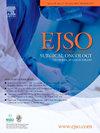在微创食管切除术和新辅助化疗时代,基于对食管癌外科显微解剖的了解,保留和切除食管癌的肿瘤预后
IF 3.5
2区 医学
Q2 ONCOLOGY
引用次数: 0
摘要
虽然胸导管切除术的肿瘤学益处已被报道,但最近的研究对其对生存率的影响提出了质疑。随着微创食管切除术(MIE)技术的进步和对显微解剖学的深入了解,标准化的食管切除/保存技术变得越来越重要。我们在接受新辅助化疗的患者中展示了一种微创食管切除术,有或没有TD切除术。方法本多中心、回顾性队列研究评估了2012年至2019年在日本两家癌症中心接受新辅助化疗后行胸腔镜McKeown食管切除术的cT1-3胸段食管癌患者。采用倾向评分匹配法比较TD保存和切除的效果。分析了短期和长期结果。结果我们展示了TD切除和保存的标准程序,并证明识别膜结构对于精确切除食管和区域淋巴结至关重要。配对后,每组255例患者进行分析。与TD保留组相比,TD切除组在短期预后、并发症发生率或胸淋巴结收获方面没有显着差异。两组患者的5年总生存率和无复发生存率相似,复发模式无显著差异。结论在以MIE和新辅助化疗为标准的现代食管癌治疗背景下,TD切除术对预后的影响有限。识别膜结构对于使用MIE入路进行准确的食管切除术至关重要。本文章由计算机程序翻译,如有差异,请以英文原文为准。
Oncological outcomes of thoracic duct preservation and resection for esophageal carcinoma based on an understanding of its surgical microanatomy in the era of minimally invasive esophagectomy and neoadjuvant chemotherapy
Background
Although the oncological benefits of thoracic duct (TD) resection have been reported, recent research has questioned its impact on survival. With advancements in minimally invasive esophagectomy (MIE) and a deeper understanding of the microanatomy, standardizing techniques for TD resection/preservation have become increasingly important. We demonstrated a minimally invasive surgical procedure for esophagectomy, with and without TD resection, in patients who received neoadjuvant chemotherapy.
Methods
This multicenter, retrospective cohort study evaluated patients with cT1–3 thoracic esophageal cancer who underwent thoracoscopic McKeown esophagectomy after neoadjuvant chemotherapy at two Japanese cancer centers between 2012 and 2019. The effects of TD preservation and resection were compared using propensity score-matching. Short- and long-term outcomes were analyzed.
Results
We showed the standard procedure for TD resection and preservation and demonstrated that recognizing membrane structures is crucial for precise resection of the esophagus and regional lymph nodes. After matching, 255 patients in each group were analyzed. The TD resection group showed no significant differences in short-term outcomes, complication rates, or thoracic lymph node harvest compared to the TD preservation group. Both groups had similar 5-year overall and recurrence-free survival rates, with no significant differences in recurrence patterns.
Conclusions
In the context of modern esophageal carcinoma treatment, in which MIE and neoadjuvant chemotherapy are standard practices, the impact of TD resection on prognosis is limited. Recognizing membrane structures is crucial for accurate esophagectomy using the MIE approach.
求助全文
通过发布文献求助,成功后即可免费获取论文全文。
去求助
来源期刊

Ejso
医学-外科
CiteScore
6.40
自引率
2.60%
发文量
1148
审稿时长
41 days
期刊介绍:
JSO - European Journal of Surgical Oncology ("the Journal of Cancer Surgery") is the Official Journal of the European Society of Surgical Oncology and BASO ~ the Association for Cancer Surgery.
The EJSO aims to advance surgical oncology research and practice through the publication of original research articles, review articles, editorials, debates and correspondence.
 求助内容:
求助内容: 应助结果提醒方式:
应助结果提醒方式:


